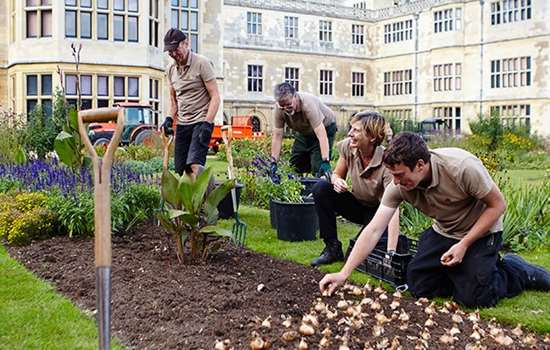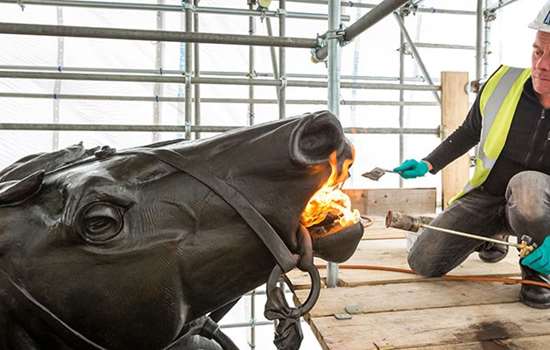21/09/2016
New Diversity initiative for London Blue Plaques, as footballer Laurie Cunningham honoured
- Pioneer of black achievement in football honoured with English Heritage blue plaque
- New working group will advise on diversity in the blue plaques scheme
A new working group tasked with proposing Black and Asian nominees for the London Blue Plaques scheme is being created, English Heritage announced today (21 September 2016) at the unveiling of a blue plaque to footballer Laurie Cunningham.
There are more than 900 Blue Plaques in London, but currently less than 4% of them are dedicated to Black and Asian figures from history. This is partly explained by the low number of public nominations fulfilling the blue plaque criteria, and by the lack (or relative inaccessibility) of historic records establishing a definitive link between the person in question and the building in which they lived.
The working group will be led by English Heritage Blue Plaque panel member Augustus Casely-Hayford, a curator and cultural historian. Speaking about the role of the new group, Casely-Hayford said: "This great city has always been an ethnic melting pot. We are linked through language, culture, political alliance and economic partnership to every part of the world. And peoples from places that we have touched, have found their way here, to not just make London their home, but to make London and this country what it is.
"We want to celebrate that rich complex, sometimes, difficult history, through the lives of those that truly made it."
Diversity in the Blue Plaques scheme
The London Blue Plaques scheme was established 150 years ago in 1866 but it wasn't until 1954 that the first plaque honouring a notable figure of minority ethnic origin was installed, to Mahatma Gandhi.
The majority (66%) of the plaques commemorating black and Asian figures have been erected during English Heritage's custodianship of the scheme, reflecting an evolving sense of who should be honoured.
Black and Asian figures celebrated with English Heritage blue plaques include Mary Seacole, the heroic Jamaican nurse from the Crimean War; Chinese writer Lao She; Indian poet, Rabindranath Tagore; and guitarist and song-writer Jimi Hendrix.
Casely-Hayford continued: "The Blue Plaques Scheme faces certain specific challenges when it comes to recognising the achievements of individuals who have faced institutional barriers, who have often lived outside of the official records.
"We want to look at how those challenges can be overcome and to partner with the British public in uncovering the stories of those unacknowledged heroes who helped make our great city what it is."
Public nominations will continue to be the lifeblood of the Blue Plaques Scheme and all nominations generated by the new working group will be judged by the same strict criteria (see below) as those received from the public.
Laurie Cunningham's Blue Plaque
This announcement comes on the same day as English Heritage unveil a blue plaque to Laurie Cunningham, the first black footballer to play for England in a competitive international match. He was also the first Englishman to play for Real Madrid.
The plaque will mark his childhood home in Stroud Green, North London. Cunningham lived here when he was first spotted by a Leyton Orient scout, before making his professional footballing debut with the team in 1974.
Laurie Cunningham is only the second footballer to be recognised with a blue plaque; Bobby Moore, England's World Cup-winning captain, was honoured earlier this year.
As well as being a consummately talented footballer, Cunningham was also a pioneer of black achievement in English football. When he made his professional debut, black players were a rarity whereas today, more than a quarter of professional players in the English league are of black minority ethnic origin.
English Heritage's Curatorial Director, Anna Eavis, said: "Since 1866 when the Blue Plaques scheme was established, our idea of which figures from the past are significant has changed. Today we are honouring an incredibly gifted footballer who paved the way for many other black players. But there are many others of national importance within the black community who have not been nominated for plaques - we've established this group to help get their names and stories in front of our panel and ensure that their achievements are considered for recognition.
"We want the Blue Plaques Scheme to celebrate the contributions of those groups which traditionally have been underrepresented in history including women and the working class, Black and Asian communities."
Criteria for proposing a Blue Plaque
The London blue plaques scheme celebrates the link between significant figures of the past and the buildings in which they lived and worked. All nominations received by English Heritage, including those generated by the new working group, are judged by the same strict criteria:
- they should be regarded as eminent within their own profession or calling,
- their achievements should have made an exceptional impact in terms of public recognition or their achievements deserve national recognition,
- they must have been dead for twenty years,
- they should have lived in London for a significant period, in time or importance, within their life and work,
- the London building in which they lived or worked should still survive and must not have a significantly altered exterior.
This year marks the 150th anniversary of the English Heritage London Blue Plaques scheme. It is generously supported by David Pearl, the Blue Plaques Club, and members of the public.
For more from English Heritage, follow us on Facebook, Twitter or Instagram.
More recent news
-

Save our historic Daffodils and Bluebells
Campaign to help save the native and historic varieties of daffodils and bluebells, both of which are at risk from aggressive hybrids and non-traditional varieties.
-

Help protect England's Heritage
Our new fundraising appeal will help support vital conservation work at historic sites across the country.
-

Public opinion sought for Tintagel Bridge Project
A special display will gather local opinions on the proposed designs for a new bridge at Tintagel Castle over 4 days in November and December.